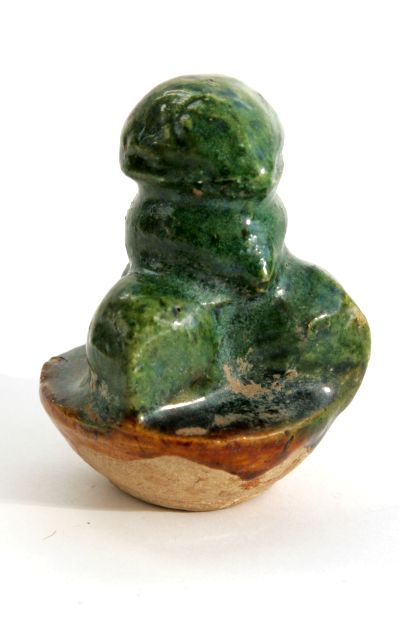
Mingqi - Small food sacrificial dish made for altar use. Miniature model of a sacrificial food dish, of five peaches symbolizing a wish for long life, and created to be used as a funerary object. Mingqi miniatures were placed in the tombs of wealthy Chinese aristocrats to accompany them into the next world eventually replacing human and real sacrifices of earlier periods. Mingqi miniatures were specifically made for placement in tombs and were not designed for daily use. Sancai lead glaze on low fired pottery. Ming dynasty (1368 till 1644), 16th century. Height c. 2.5 inches (6.5 cm)
Joan Brand-Landkamer Coll. 2015.
Literal translation: "items for the next world" or "spirit utensils". In ancient China mingqi were items made to accompany the deceased in burial. The figures provide an insights into belief systems and the daily life's of the Chinese over a thousand-year period. They reveal both how people in early China approached death and how they lived.
The idea of symbolic sacrifices came about due to the realization of the huge costs of slaughtering down real slaves and animals for burial purposes around the beginning of the Han dynasty. After a symbiotic relation between life and afterlife, during the Han dynasty, the tradition barely survived through the turbulent Six Dynasties period (221–589), into the short reunification of China in the Sui (589–618), to be revived in its ultimate glory during the Tang (618–906) dynasties. Later, in the Ming dynasty, the tradition again surfaced to outdo the Tang, if not in quality so at least in quantity.
Pottery wares specifically made for burial ceremonies and gifts flourished in the Han dynasty (206 BC-220 AD). People viewed the afterlife as an extension of the worldly life. The burial gifts encompassed a wide variety of objects including figures, horses, houses, and graceful dancers, mystical beasts, and everyday objects.
Also in this period, green-and-brown lustrous lead glazes were developed imitating more expensive bronze items and made with a green glaze probably imported from Rome. Although most mingqi were mass produced using molds, they are remarkably animated. Naturalism was central to the figures' purpose of providing the deceased with entertainment, service, and guardianship. Since most of the Han dynasty buildings were made of wood and have long since disintegrated, mingqi also preserve information about architecture in Han China.
Around the Wang Mang interruption in A.D. 9-24 of the Han rule, the tomb architectural styles changed from pits into multi chambered underground dwellings, often with elaborate carvings and wall paintings decorated with Daoist imagery and depicting paradises and stories underscoring Confucian virtues like filial piety and loyalty. The tombs were constructed of brick and featuring vaulted ceilings and were aligned along north-south axes and tied to above-ground stone shrines.
After the Han's ultimate collapse in 220 A.D. the symbiotic relationship between individual and state, as well as between life and afterlife, underwent a dramatic change. The period of disunion that followed, known as the Six Dynasties (220–589), saw an immediate reaction against ornate tombs, which were considered emblematic of excesses responsible for the downfall of the Han. Even imperial tombs were spare, reflecting ideology as well as economic realities in unstable times. The overall number of mingqi, as well as their quality, declined in the early Six Dynasties.
While many examples are painted with earth pigments which easily wears off, some of the most striking figures from the Tang dynasty (618-907) are large horses, camels, figures, and earth spirits that are partially glazed, usually in green, yellow, brown, and sometimes blue sancai enamels.
The tradition have survived until today as paper items burned as part of the funerary rituals.
A